Emre Ugur
Ph.D.
From Continuous Manipulative Exploration to Symbolic Planning
This work aims for bottom-up and autonomous
development of symbolic planning operators from continuous
interaction experience of a manipulator robot that explores
the environment using its action repertoire. Development of
the symbolic knowledge is achieved in two stages. In the
first stage, the robot explores the environment by executing
actions on single objects, forms effect and object categories,
and gains the ability to predict the object/effect categories from
the visual properties of the objects by learning the nonlinear
and complex relations among them. In the next stage, with
further interactions that involve stacking actions on pairs of
objects, the system learns logical high-level rules that return
a stacking-effect category given the categories of the involved
objects and the discrete relations between them. Finally, these
categories and rules are encoded in Planning Domain Definition
Language (PDDL), enabling symbolic planning.We realized our
method by learning the categories and rules in a physics-based
simulator. The learned symbols and operators are verified by
generating and executing non-trivial symbolic plans on the real
robot in a tower building task. (ICRA2015.pdf)
Next, the robot progressively updated the
previously learned concepts and rules in order to better deal
with novel situations that appear during multi-step action
executions. It inferred categories of the
novel objects based on previously learned rules, and form new
object categories for these novel objects if their interaction
characteristics and appearance do not match with the existing
categories. Our system further learns probabilistic rules that
predict the action effects and the next object states.
After learning, the robot was able to build stable towers in real
world, exhibiting some interested reasoning capabilities such as
stacking larger objects before smaller ones, and predicting that
cups remain insertable even with other objects inside.
(humanoids2015.pdf)
Robot Videos: ICRA & Humanoids

|
Bootstrapped learning with Emergent Structuring of interdependent affordances
It was shown that human infants develop a set of action primitives such as grasping,
hitting and dropping for single objects by 9 months, and later start exploring actions that involve
multiple-objects. For example, before 18 months they cannot perceive the correspondence between
different shaped blocks and holes and are unsuccessful in inserting blocks in
different shapes. This data suggests that there exists a developmental
order where infants first develop basic skills that are precursors of combinatory manipulation
actions. They also probably use the learned action grounded object properties
in further learning of complex actions.
Here we propose a learning system for a developmental robotic system that benefits from bootstrapping, where learned simpler structures (affordances) that encode robot's interaction dynamics with the world are used in learning of complex affordances. We showed that a robot can benefit from a hierarchical structuring, where pre-learned basic affordances are used as inputs to bootstrap the learning performance of complex affordances (ICDL2014-Bootstrapping.pdf). A truly developmental system, on the other hand, should be able to self-discover such a structure, i.e. links from basic to related complex affordances, along with a suitable learning order. In order to discover the developmental order, we use Intrinsic Motivation approach that can guide the robot to explore the actions it should execute in order to maximize the learning progress. During this learning, the robot also discovers the structure by discovering and using the most distinctive object features for predicting affordances. We implemented our method in an online learning setup, and tested it in a real dataset that includes 83 objects and large number of effects created on these objects by three poke and one stack action. The results show that the hierarchical structure and the development order emerged from the learning dynamics that is guided by Intrinsic Motivation mechanisms and distinctive feature selection approach (ICDL2014-EmergentStructuring.pdf).
Robot Video
Here we propose a learning system for a developmental robotic system that benefits from bootstrapping, where learned simpler structures (affordances) that encode robot's interaction dynamics with the world are used in learning of complex affordances. We showed that a robot can benefit from a hierarchical structuring, where pre-learned basic affordances are used as inputs to bootstrap the learning performance of complex affordances (ICDL2014-Bootstrapping.pdf). A truly developmental system, on the other hand, should be able to self-discover such a structure, i.e. links from basic to related complex affordances, along with a suitable learning order. In order to discover the developmental order, we use Intrinsic Motivation approach that can guide the robot to explore the actions it should execute in order to maximize the learning progress. During this learning, the robot also discovers the structure by discovering and using the most distinctive object features for predicting affordances. We implemented our method in an online learning setup, and tested it in a real dataset that includes 83 objects and large number of effects created on these objects by three poke and one stack action. The results show that the hierarchical structure and the development order emerged from the learning dynamics that is guided by Intrinsic Motivation mechanisms and distinctive feature selection approach (ICDL2014-EmergentStructuring.pdf).

|
Brain Mechanisms in Antropomorphic/Non-Antropomorphic Tool Use
A tool (a rake allowing the manipulation of objects out of reach)
is grabbed by a trained monkey, parietal neurons with receptive fields
on and around the hand expand their receptive fields to represent the tool.
Since the human gains the ability to manipulate objects
using a robot, can we project from
the finding mentioned above that the body schema of a human
operator expands to include the
robot in the course of controlling it? And if so, what are
properties of this body schema expansion.
Does the control of all kind of robot morphology induce similar
changes in the brain? To investigate these questions we designed an fMRI experiment. Our
hypothesis is, that the anthropomorphicity of the robot to be controlled would be critical
to how it was represented in the brain.
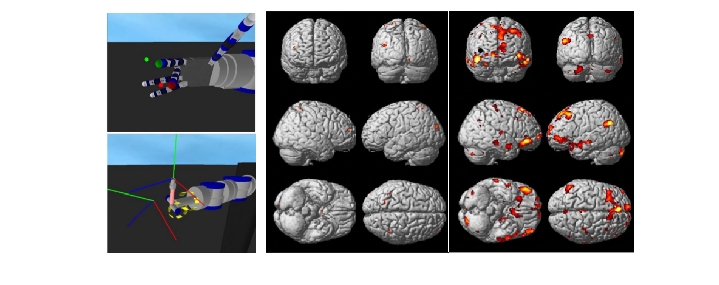
|
Reconstruction of Grasp Posture from MEG Brain Activity
We aim at both decoding the grasp
type (power vs. precision pinch) and reconstructing the aperture size
based on MEG signals obtained while the subjects performed repetitive
flexion and extension finger movements corresponding to either
precision pinch or power grasp. During the movements, finger joint
angles were recorded along with MEG signals using an MEG compatible
data glove. For learning the mapping between MEG signals and grasp
types, support vector machines with linear kernel is used. For
reconstructing the aperture size, a sparse linear regression method is
used. (poster)
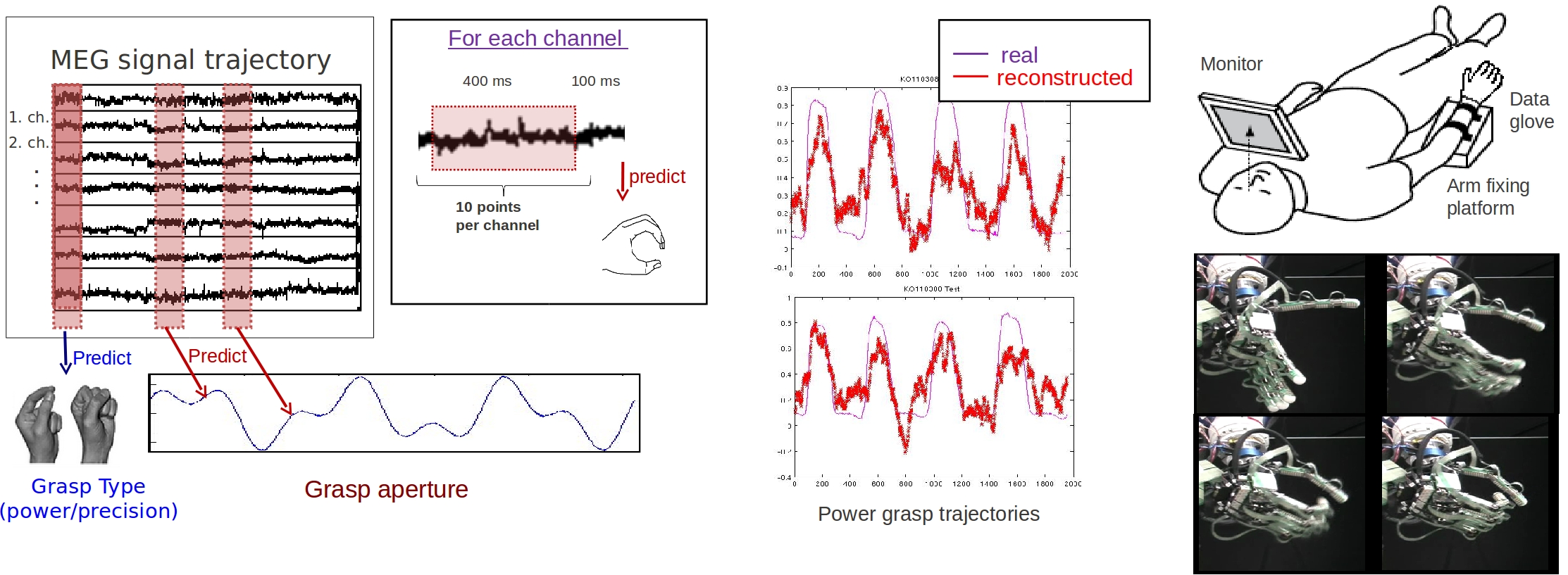
|
Learning Object Affordances and Planning in Perceptual Space
The objective of this research topic is to enable an antropomorphic
robot to learn object affordances through self-interaction and
self-observation, similar to exploring infants of 7-10 months age.
In the first step of learning, the robot discovers commonalities in its
action-effect experiences by discovering
effect categories. Once the effect categories are discovered, in
the second step, affordance predictors for
each behavior are obtained by learning the mapping from the object
features to the effect categories.
After learning, the robot can make plans to achieve desired goals,
emulate end states of demonstrated
actions, monitor the plan execution and take corrective actions
using the perceptual structures employed
or discovered during learning.
(videos)
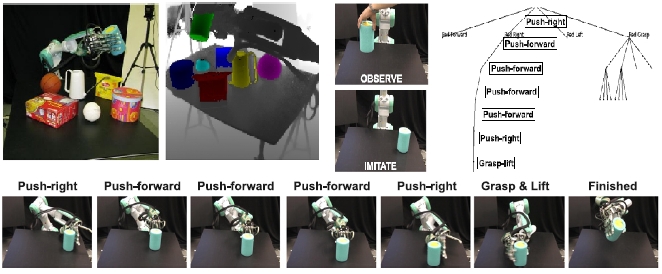
|
Learning Grasp Affordances through Parental-Scaffolding
Parental scaffolding is an important mechanism
utilized by infants during their development. A robot with the
basic ability
of reaching for an object, closing fingers and lifting its hand
lacks knowledge of which parts of the object affords grasping,
and in which hand orientation should the object be grasped.
During reach and grasp attempts, the movement of the robot
hand is modified by the human caregiver’s physical interaction
to enable successful grasping. Although the human caregiver does
not directly show the graspable regions, the robot should be able to
find regions such as handles of the mugs after its action execution
was partially guided by the human.
(videos)
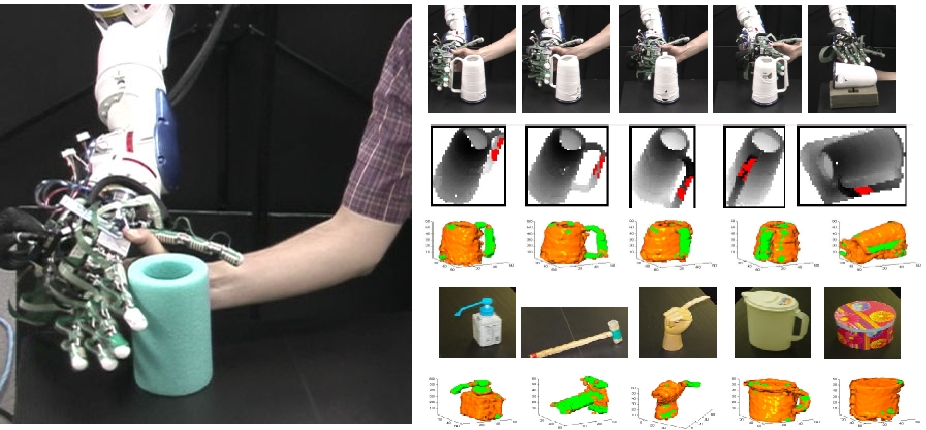
|
Learning Traversability Affordances
We studied how a mobile robot,
equipped with a 3D laser scanner, can learn to perceive the
traversability affordance and use it to wander in a room filled
with spheres, cylinders and boxes. The results showed that after
learning, the robot can wander around avoiding contact with
non-traversable objects (i.e. boxes, upright cylinders, or lying
cylinders in certain orientation), but moving over traversable
objects (such as spheres, and lying cylinders in a rollable
orientation with respect to the robot) rolling them out of its
way.
(videos)
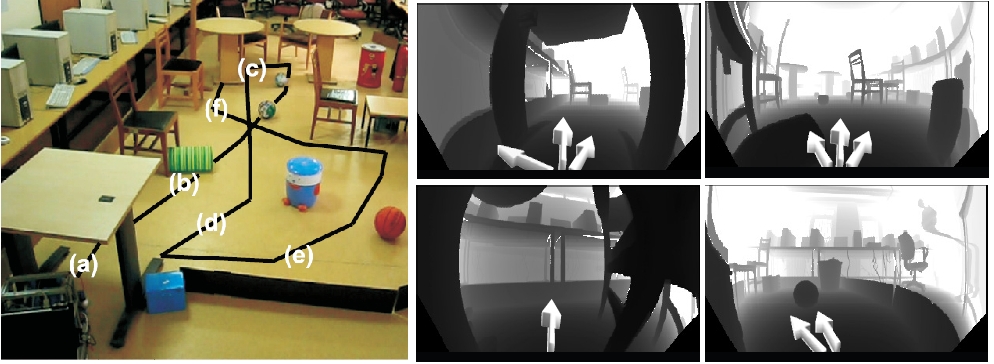
|